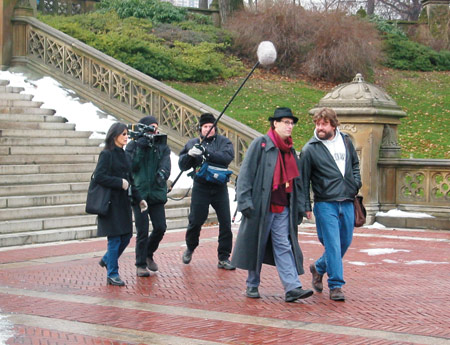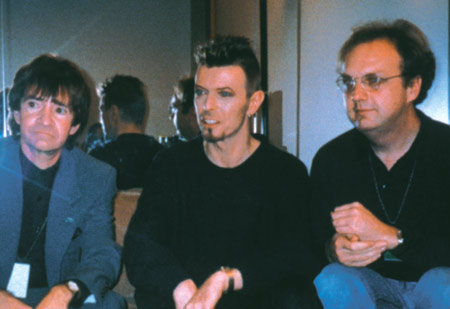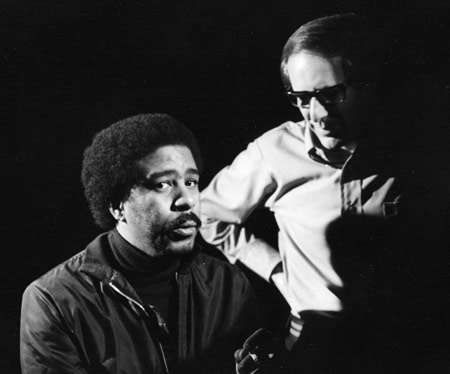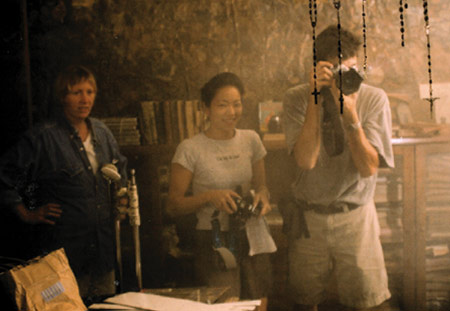Director Stacy Peralta
When Stacy Peralta's skateboarding documentary, Dogtown and Z-Boys, premiered at the 2001 Sundance Film Festival, it sold out its screenings before anyone had seen it and won the festival's Audience Award and Director's Award. This year, Peralta's surfing documentary, Riding Giants, opens the festival, marking the first time Sundance has selected a documentary to screen on opening night.
"It is a wonderful work that has really special qualities to it," Sundance Film Festival director Geoff Gilmore told indieWire. "It is a great, fun film for us to start with."
"Fun" is not necessarily the first thing people associate with documentaries. But it has become part of the repertoire of words to describe contemporary nonfiction films that now includes "entertaining" and "dramatic" as well as the typical "informative," "educational" and "historical."
"One year I was on [Sundance's] documentary jury and it was so much fun because I got to see all 16 documentaries," says Jessica Yu, an Academy Award winner for her 1996 short subject, Breathing Lessons: The Life and Work of Mark O'Brien. Her feature length In the Realms of the Unreal on outsider artist Henry Darger debuts in this year's Sundance Documentary Competition. "People don't get the experience to watch all 16 so it's hard for them to really understand how amazing the selection is. If you look at the documentaries that have done well in the past few years, there is such a variety of subject matter and styles. That vibrancy makes it very hard to classify the genre."

Director Freida Lee Mock (far left) on location for her latest film, Wrestling with Angels - Playwright Ton Kushner
No subject is too big, small or taboo for a documentary film. The Cuban musicians of Wim Wenders' Buena Vista Social Club, spelling bee contestants in Spellbound, baseball great Hank Greenberg's life, Shackleton's Antarctic journey, the birds of Winged Migration, the story of World War II kindertransports featured in Into the Arms of Strangers, gun ownership in America as seen through Michael Moore's eyes in Bowling for Columbine and Robert McNamara filtered through Errol Morris' The Fog of War have made their way into movie theaters and audiences' hearts and minds.
"They're being distributed and seen, and they're building an audience," says Freida Lee Mock, Academy Award winner and DGA nominee for Maya Lin: A Strong Clear Vision, who is currently working on a feature-length portrait of playwright Tony Kushner (Angels in America, Homebody/Kabul). Mock also chairs the Academy's Documentary Executive Committee and serves with director Michael Apted as a governor of the Academy's Documentary Branch.
As distinct as these well-received documentaries are, they share a common element: filmmakers' wholehearted, intense curiosity about their subjects. The process of making any compelling documentary begins with that curiosity.
"When the punk movement happened, I just felt possessed to document it," says Penelope Spheeris referring to her 1981 film, The Decline of Western Civilization. "I would walk up to people in clubs that were filming or shooting even still cameras and say, 'I'm sorry you can't shoot here, I'm doing this movie,' and they would stop. That would never happen today."
Spheeris' upbringing was similar to that of the outsider-type, rock 'n' roll rebellious kids in her film, and she felt a kinship with them. Initially when George Hickenlooper was approached to document DJ Rodney Bingenheimer's life, as he has in Mayor of the Sunset Strip, opening in theaters in March, he was "on the fence because I'm not a pop music connoisseur. Rodney graciously invited me to his home, and I saw that his room was covered floor to ceiling with photographs of himself with pop stars and movie stars from Jimi Hendrix to the Beatles, Alec Baldwin and Jodie Foster. And Rodney became luminous when he was around these photographs. I was wondering: What was it that would make him feel that way? The reason for me to make the film was that I saw a little bit of myself in Rodney. I started asking questions about what drew me to Hollywood. In that idea, I saw a compelling universal story about what it is that draws us here — and, ultimately, I think the overall theme of the film, and I think all documentaries should have a theme, is that we want and need to be loved and celebrity is a function of that human need."
Sometimes it's a serendipitous moment that attracts a filmmaker to her next subject. "I was giving a talk in Chicago about The Living Museum, a film I had made for HBO about a group of artists in a mental institution in New York," Yu says. "A man in the audience asked me if I had heard of Henry Darger and took me to see the room where this man lived for 40 years. It was one of those experiences where I didn't go there intending to do research for a film, but as soon as I stepped into that room, my heart started beating and it just felt like ... his presence was so strong. There was a feeling of a story that hadn't quite been put together. Five years later we're finally finishing the film."

(Top) Rodney Bingenheimer, David Bowie and director George Hickenlooper from Mayor of the Sunset Strip (below) Richard Pryor and Mel Stuart during production of Wattstax

Often, it is volatile, unresolved history that entices filmmakers to devote years to trying to make sense of that past. Charles Burnett says of his documentary on the leader of the 1831 slave rebellion, Nat Turner: A Troublesome Property: "We went to the location; we interviewed people. You feel spiritually connected in a certain way because you see these incidents that happened in the past — and the tragedy — and you feel as though you are trying to somehow resolve a lot of these issues by making this film.
When filming a documentary, Burnett says he tries to make it as objective as possible. "A fictional film, there's more of an 'about me' kind of thing in it. Eventually it's all about you, but a documentary is external. It's more clearly defined that you're more interested in humanity than personal gain. People get involved with it because they want to either confirm or change the world."
"Any good work of art tries to show you there's a different way of seeing the world," says Errol Morris. "I'm very proud of the fact that I am, among other things, an investigative filmmaker. I have found out surprising things in the course of making movies. I uncovered what I would call a major miscarriage of justice in Texas that led to an innocent man being released from prison; his sentence overturned (The Thin Blue Line).
"One of the reasons that [the film] actually got Randall Adams out of jail was because it wasn't just about someone investigating a crime. It actually caught part of that investigation on film. I was able to take the dailies from crucial eyewitnesses, and they were submitted into evidence in federal court. Those interviews could be used to impeach the testimony of witnesses at trial, to show that they had committed perjury. So they were actual pieces of evidence. It's documentary in a very strong form, and I believe The Fog of War is the same way.
It tells a very important and interesting story about World War II that is virtually unknown: the firebombing in Japan. It was unknown that [Robert] McNamara was so involved. When you see those numbers falling over Tokyo, they're his handwritten numbers. We found his memos, his notes in the National Archives — and I believe we were the first people to look at that material since 1945."

Director Errol Morris
Morris is particularly proud of his juxtaposition of two audiotape conversations: one, recently released, between John Kennedy and McNamara in which McNamara says we need a way to get out of Vietnam; the other between McNamara and Lyndon Johnson three months after Kennedy was assassinated. They tell us, Morris says, "something about McNamara's role at the beginnings of escalation [in Vietnam] that is completely at variance with the general theory that we are told about this.
"My films work off of language, often, in recent years, monologue," Morris says. "The Fog of War is a movie that tries to tell a story about an individual in the world. It's a different way of telling a historical story than what we're used to seeing. It's almost a stream of consciousness narration. You're listening to his experience of his life in his own words. It's subjective but set amongst this narration are pieces of evidence — whether they're notes, memoranda or voice recordings. It's what we normally don't see in history books."
"A documentary is at its best when you feel like you are living inside an unfolding novel," says Steve James (Stevie and the DGA Award-winning Hoop Dreams). "Hoop Dreams felt like Dickens in a way. It had lots of plot turns, dramatic turns and ironies that piled on top of ironies like a good Dickens novel. Stevie felt like Faulkner: a tortured family.
"By doing documentaries you experience other people's lives on an intimate and complicated level that you just don't get easily in your everyday life," James explains. "Where would I spend time with Nigerian refugees in Chicago if not through the work that I've done?" he said, referring to his direction of an episode of the three-part PBS The New Americans documentary series airing in March. James also served as the series' executive producer. He's currently editing Reel Paradise, which chronicles a month in the life of indie film guru John Pierson (Spike, Mike, Slackers & Dykes) in Fiji. Pierson lived there with his family and ran a remote movie theater on one of the islands.
"There are many good things about this film, not the least of which is I didn't have to raise the money for the first time in a long time," says James about Reel Paradise. "I'm happy because we were able to make it a DGA film. I was determined to find a way with the help of the DGA and [DGA Midwestern Executive Director] Dan Moore to make this a DGA film so that I could get the benefits that come from DGA membership. It took some doing to make it happen because the budget is not big. There was some real give and take on both sides to make this work." The film, to be distributed by Miramax, was made under the Low Budget Agreement and done under a special sideletter to address the unique terms and conditions relating to documentary production.
"The verb to use is cobble," Mock says, regarding the film funding process. "That's typical of independents. I did receive a National Endowment for the Arts grant for the Kushner film, as I did for Maya Lin, but it's never 'the end.' One has to continue to fundraise. Maya Lin took five years, and I was still fundraising the day it came out of the lab."
There can be long gaps between projects, according to Yu, whose Sundance entry was five years in the making. "The majority of your time is spent filling out proposals or looking for money or having other jobs. We had interest from a lot of people and places, but it was important to keep creative control and at the same time keep the project moving forward so it didn't just die.

On the set of In the Realms of the Unreal, are (from left) associate producer Karen Carter, director Jessica Yu and cinematographer Russell Harper
"The thing about documentaries is that if you find a subject that really turns you on, you can jump into it," Yu says. "You can start the research. I had the opportunity to film in Darger's room before it was dismantled. I still didn't know quite what the film was going to be about, but I just called friends and met some really wonderful people who work in commercials in Chicago. And we had this great crew. On a typical documentary shoot, you've got three people with two of them related to you, one light and one zoom lens. Just being able to act on your enthusiasm is hard to do in narrative features where everything has to be in place before you get started."
"Documentaries are really gratifying because they take you on a journey," according to Spheeris. "You start out with a certain subject in mind and if you're doing it right, the subject matter guides you, and you learn a lot about this subject and about life. When it's not working well is when the filmmaker is trying to impose something on the subject that isn't really there. So it's about learning and the excitement of new adventure."
"I sat in a room for two hours with President Johnson," recalls Mel Stuart, a director with more than 150 documentaries to his credit, including The Making of the President 1960 and 1968 as well as the 1973 Wattstax concert documentary. "I was at a table where Louis Leakey and Robert Audrey discussed how laughter developed in primitive man. For a documentary I did about Sophia Loren, she showed me how to make spaghetti. I talked to an agent in the KGB and had him show me all their secret killing weapons. I've been chased by an elephant in Kenya, fallen into quicksand and, sadly, I was right behind Bobby Kennedy when he was assassinated at the Ambassador Hotel. These are experiences you do not get making a feature or a sitcom, and your life is enriched."
One of Stuart's first jobs was as a film researcher for Walter Cronkite's The Twentieth Century television program. "You come on a set and there's no script, no set pattern and nobody's waiting to perform for you. You better be quick and alert and know what shots you want and how to frame the scenes immediately. One day, [my cameraman and] I went into the Oval Office when Johnson was there and they were talking about Vietnam. He looked at me and said, 'Boy, you've got 30 seconds.' I knew what I had to get and I got it. Thirty seconds later, security touched me on the shoulder and threw me out of the room."

Filming Stevie. Subject Stephen Fielding with fishing pole, and from left, cinematographer/producer Gordon Quinn, director Steve James, soundman/producer Adam Singer
"Documentaries are challenging and rewarding because you're creating a story out of virtual chaos," Hickenlooper says. "The approach is completely anti-thetical to feature films where you have a blueprint — a screenplay — and you build on that. With documentary filmmaking it's more like free association writing. I think it's cinema in its purest form because you are telling a story by juxtaposing images and ideas. My production company, Kino-Eye American, is an homage to Kino-Eye, a school of filmmaking in Russia pioneered by Dziga Vertov. He basically created the idea of cinema vérité where you let the camera roll and let life unfold in front of the camera."
"You have to treat your subjects as partners in this mutual journey that you're taking," James says. "They have to be able to feel they can trust you, that you care about them. If they don't feel that, they're not going to open up to you or want you around. They also have to feel, to some extent, like they have some control, that there are things they can say that are 'off limits' and you will honor that.
"To have that long-term engagement with a story that's unfolding in real life," adds James, who followed the basketball players in Hoop Dreams on and off more than 4½ years, "you have to constantly anticipate where that story is going and plan for what you need to get in order to make that come through in the film. You may start with one story in mind, but inevitably you're going to end up someplace completely different and better, more interesting and complicated and revealing than what you imagined it might be.
"When Hoop Dreams came out, Stuart Klawans, who writes for The Nation, said, 'Hoop Dreams had a script by God,' which has always stuck with me, not so much as a compliment to Hoop Dreams because he's right, we didn't script it. Fate scripted what happened in Hoop Dreams. It's always struck me as an apt description of what it is that I love best about doing documentaries."
The characters that populate a documentary also determine whether or not it's successful in capturing the events. "Casting in documentaries is as important as casting in features," Stuart says. "Certain people have screen presence. Kennedy had it, Nixon didn't."
"You have to be very careful who you put in your film," agrees Peralta who, as with Dogtown, has Sean Penn narrating Riding Giants. "When I first met [legendary surfer] Greg Noll, my initial gut feeling was I could make a film about this guy. He's so good on camera. It's super important. Some people are simply not good on camera but you may need them in the film, so to make them palatable, you have to surround them with people who are dynamic on camera. You're asking people to sit down and watch a piece of history, but you have to make it a great ride for them."
The financial rewards of making documentaries do not compare with those of fiction films or a good run on a sitcom. However, says Stuart, "there's one major satisfaction: You are making something that becomes part of the chronicles of our time. That's the riches of working in the documentary field. If we could get at the television archives of the early Roman Empire, if they had existed, which would you rather see, a documentary on Christ or Caesar or an old Roman version of a sitcom? Which would you want to preserve?"